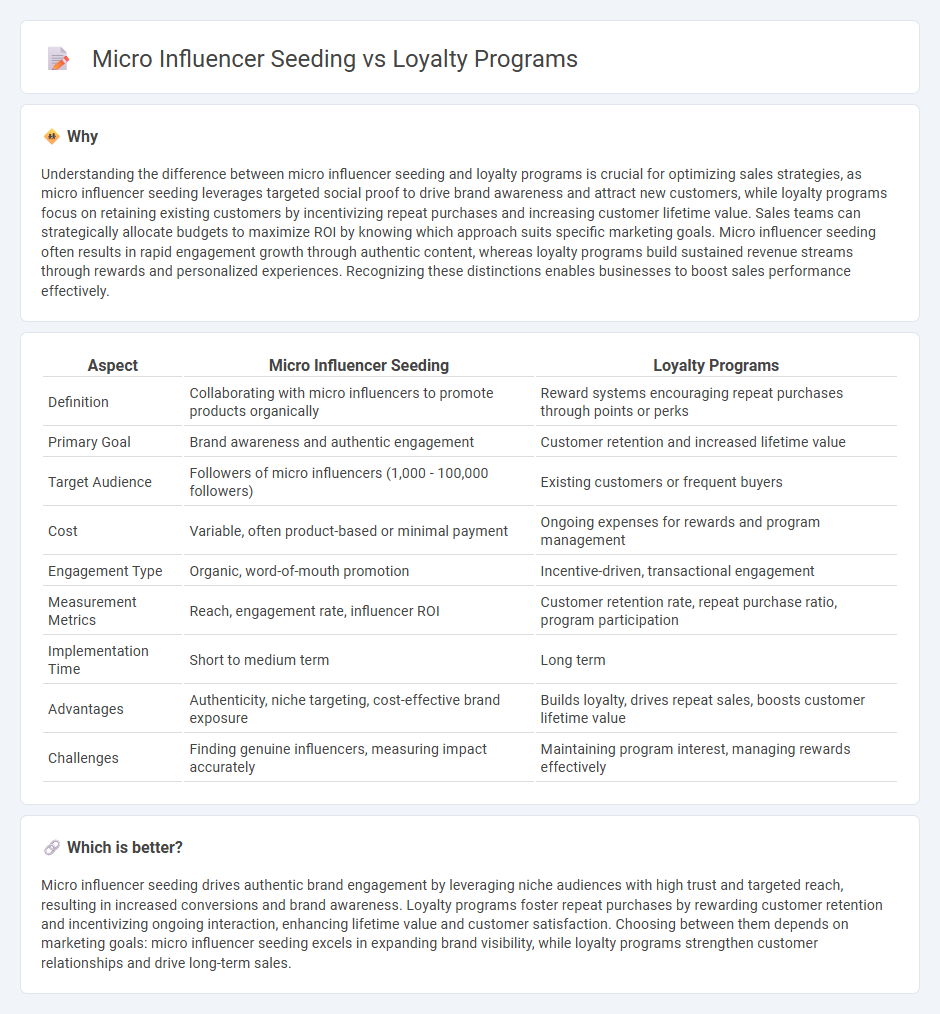
Micro-influencer seeding leverages authentic, niche content creators to organically promote products, driving higher engagement and brand trust compared to traditional methods. Loyalty programs focus on retaining customers by rewarding repeat purchases, fostering long-term brand affinity and increasing customer lifetime value. Explore the strategies and benefits of micro-influencer seeding versus loyalty programs to optimize your sales approach.
Why it is important
Understanding the difference between micro influencer seeding and loyalty programs is crucial for optimizing sales strategies, as micro influencer seeding leverages targeted social proof to drive brand awareness and attract new customers, while loyalty programs focus on retaining existing customers by incentivizing repeat purchases and increasing customer lifetime value. Sales teams can strategically allocate budgets to maximize ROI by knowing which approach suits specific marketing goals. Micro influencer seeding often results in rapid engagement growth through authentic content, whereas loyalty programs build sustained revenue streams through rewards and personalized experiences. Recognizing these distinctions enables businesses to boost sales performance effectively.
Comparison Table
| Aspect | Micro Influencer Seeding | Loyalty Programs |
|---|---|---|
| Definition | Collaborating with micro influencers to promote products organically | Reward systems encouraging repeat purchases through points or perks |
| Primary Goal | Brand awareness and authentic engagement | Customer retention and increased lifetime value |
| Target Audience | Followers of micro influencers (1,000 - 100,000 followers) | Existing customers or frequent buyers |
| Cost | Variable, often product-based or minimal payment | Ongoing expenses for rewards and program management |
| Engagement Type | Organic, word-of-mouth promotion | Incentive-driven, transactional engagement |
| Measurement Metrics | Reach, engagement rate, influencer ROI | Customer retention rate, repeat purchase ratio, program participation |
| Implementation Time | Short to medium term | Long term |
| Advantages | Authenticity, niche targeting, cost-effective brand exposure | Builds loyalty, drives repeat sales, boosts customer lifetime value |
| Challenges | Finding genuine influencers, measuring impact accurately | Maintaining program interest, managing rewards effectively |
Which is better?
Micro influencer seeding drives authentic brand engagement by leveraging niche audiences with high trust and targeted reach, resulting in increased conversions and brand awareness. Loyalty programs foster repeat purchases by rewarding customer retention and incentivizing ongoing interaction, enhancing lifetime value and customer satisfaction. Choosing between them depends on marketing goals: micro influencer seeding excels in expanding brand visibility, while loyalty programs strengthen customer relationships and drive long-term sales.
Connection
Micro influencer seeding leverages trusted individuals to authentically promote products, boosting brand awareness and driving customer engagement. Loyalty programs enhance this effect by rewarding repeat purchases, encouraging micro influencers' followers to convert into loyal customers. Combining both strategies creates a synergistic sales growth model through increased trust, ongoing interaction, and sustained consumer commitment.
Key Terms
**Loyalty Programs:**
Loyalty programs enhance customer retention by rewarding repeat purchases and fostering brand affinity through exclusive perks, points, or discounts. These programs generate valuable first-party data that helps brands personalize marketing efforts and increase lifetime customer value. Explore how loyalty programs can strategically elevate your brand's customer engagement and profitability.
Rewards
Loyalty programs incentivize repeat purchases by offering structured rewards such as points, discounts, or exclusive perks that increase customer retention and lifetime value. Micro influencer seeding leverages authentic endorsements from niche influencers to boost brand visibility and engagement, often providing free products or exclusive deals as incentives. Explore more about how these strategies can maximize your brand's rewards impact.
Retention
Loyalty programs drive long-term retention by rewarding repeat customers with points, discounts, and exclusive offers, fostering brand loyalty and increasing customer lifetime value. Micro influencer seeding enhances retention by authentically promoting products through trusted voices, creating deeper emotional connections and encouraging repeat purchases. Explore how combining loyalty programs with micro influencer seeding can amplify customer retention and boost sustained engagement.
Source and External Links
Loyalty programs: How they work, examples, and tips - Loyalty programs are customer retention strategies and come in types such as points-based, tier-based, and mission-based, each rewarding customers for purchases, spending levels, or supporting causes respectively.
21 Examples of Successful Loyalty Programs in 2025 - Successful examples include Starbucks Rewards, which combines points and tier elements to boost spending and retention, with 34.3 million active users and $1.85 billion in stored value as of early 2025.
10+ businesses with the best loyalty programs [2025] - H&M Membership is a points-based program rewarding purchases and recycling, with perks like birthday discounts and VIP treatment, attracting over 200 million members to date.
 dowidth.com
dowidth.com